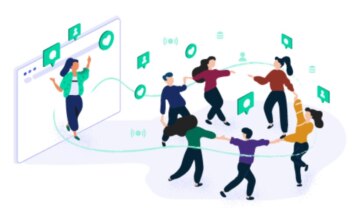As we have mentioned before, there are different engagement types marketers and event practitioners need to consider before running an event. This is because it is much easier to align the event you want to run with the type of engagement you want from your audiences.
In the past, most organizations used a taxonomy of event types to plan their physical experiences. But hybrid and digital event types have changed the equation.
Organizations now need to unify all of their event types with engagement approaches, different types of customer engagement, and techniques to create better audience experiences.
Creating Event Sessions with Multiple Engagement Types

There are also scenarios where a single experience — digital, physical or hybrid — can incorporate multiple engagement types.
For example, you may want to begin with an event where audiences are being educated on information (Consumption) before entering a breakout session where interaction is key (Participation). Another option of engagement types would be an experience where audiences move from participation to an informal networking session.
Engagement Types Matter For Large Experiences

The ability to facilitate these transitions is crucial. For example, half-day, full-day and multi-day events often include sessions with different engagement types in mind. It’s essential you construct each session to drive the engagement you want.
The distribution of these engagement types is important as well. You don’t want to overload any one day or segment towards a single type of session experience. In fact, a properly mapped agenda will also help align expectations and ensure appropriate metrics for success are set up at the session level.
Another important element to consider is audience-led programming. These are sessions where audiences get to set their own agenda.
Most of the time, organizers create either tracks or a curated set of programming that aligns to a theme or persona. Event and marketing teams should treat these as recommendations rather than prescriptions for audiences.
Putting Engagement Types Into Practice

Aside from taking this information and planning for future events, it’s also helpful to use this structure to better think about past events as well.
For example, did you have a great event but felt like participation and engagement were low? Perhaps you had expectations for a participatory event but delivered it through an experience made for consumption.
Additionally, clearly stating what engagement type you are using for future events, and putting more thought into the types of customer engagement you are going to use, will make sure you have an events portfolio that is balanced in the engagement that it is trying to drive.
Especially in companies where events are being used to reach multiple audiences, you must use your portfolio as an audit mechanism. For example, you wouldn’t want to create Networking-only engagement types for audiences looking to be educated and maybe doing research for an upcoming purchase.
Seek Out Opportunities for Innovation

Marketers and events teams have a rapid landscape of event types to explore. While the Center for Marketing Transformation has outlined sample event types above, there is a massive amount of innovation that can occur within the construct of engagement-led experiences.
Furthermore, decoupling the engagement types you’re looking to drive from the delivery mechanism (in-person, digital or hybrid) allows marketers to put engagement at the center, rather than a marketing-led construct of the delivery mechanism. Doing so will also empower teams to better evaluate the success of an event by using metrics that align to engagement type, rather than simple vanity metrics.
